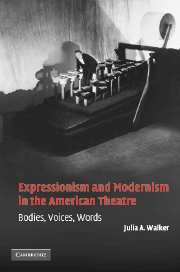Book contents
- Frontmatter
- Contents
- List of illustrations
- Acknowledgments
- Part I Introduction
- 1 Bodies: actors and artistic agency on the nineteenth-century stage
- 2 Voices: oratory, expression, and the text/performance split
- 3 Words: copyright and the creation of the performance “text”
- Part II Introduction
- Notes
- Works cited
- Index
3 - Words: copyright and the creation of the performance “text”
Published online by Cambridge University Press: 22 September 2009
- Frontmatter
- Contents
- List of illustrations
- Acknowledgments
- Part I Introduction
- 1 Bodies: actors and artistic agency on the nineteenth-century stage
- 2 Voices: oratory, expression, and the text/performance split
- 3 Words: copyright and the creation of the performance “text”
- Part II Introduction
- Notes
- Works cited
- Index
Summary
In 1903, the united states supreme court ruled on the case of Bleistein v. Donaldson Lithographing Co., in which the defendant had unlawfully copied three chromolithographed circus posters designed by the plaintiff. The question before the court was whether or not these posters, designed as advertisements, were eligible for copyright protection. The Sixth Circuit Court had decided they were not, ruling that the law, based upon its Constitutional charter, was intended to protect only the “useful arts.” The three posters, having been created solely for commercial purposes, did not fall under this category of protection. Not only were they not “works connected with the fine arts,” they were deemed “immoral,” depicting as they did “a ballet, a number of persons performing on bicycles, and groups of men and women whitened to represent statues.” As Sixth Circuit Judge Walter Evans wrote, “The court cannot bring its mind to yield to the conclusion that such tawdry pictures as these were ever meant to be given the enormous protection of not only the exclusive right to print them, but the additional protection of a penalty of a dollar each for reprints from them” (Bleistein v. Donaldson 2).
Although the Supreme Court agreed that, “Picture-posters or show bills … are not designed for close inspection or long-continued study, like an oil painting, a steel or wood engraving, or an etching,” that, rather, they are “intended to catch the eye of the passer on the street, or any one who merely glances at them, and to challenge his attention, – if possible to compel him to look again, so that he will observe what is the subject of the poster and have this forced upon his mind, and will be attracted by it,” it overturned the lower court's decision, arguing that such posters are eligible for copyright protection since they “require artistic ability, and above all things creativeness or originality of a high order, but peculiar.”
- Type
- Chapter
- Information
- Expressionism and Modernism in the American TheatreBodies, Voices, Words, pp. 84 - 110Publisher: Cambridge University PressPrint publication year: 2005



